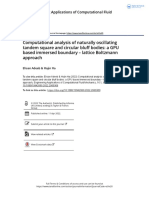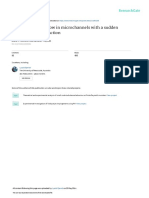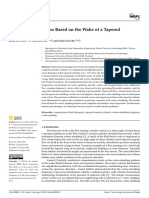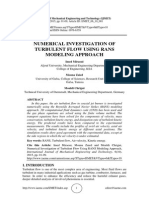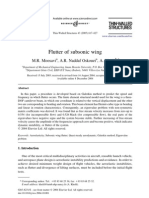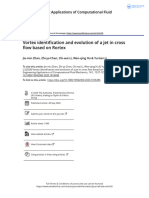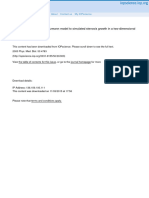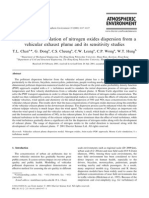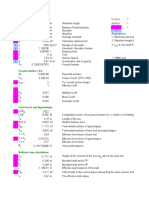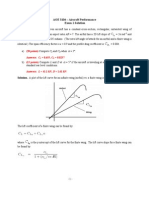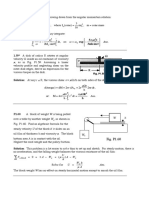CFD Experimental Study of A Round Jet in Cross-Flow at Low Momentum Ratio PDF
CFD Experimental Study of A Round Jet in Cross-Flow at Low Momentum Ratio PDF
Uploaded by
mojicapCopyright:
Available Formats
CFD Experimental Study of A Round Jet in Cross-Flow at Low Momentum Ratio PDF
CFD Experimental Study of A Round Jet in Cross-Flow at Low Momentum Ratio PDF
Uploaded by
mojicapOriginal Title
Copyright
Available Formats
Share this document
Did you find this document useful?
Is this content inappropriate?
Copyright:
Available Formats
CFD Experimental Study of A Round Jet in Cross-Flow at Low Momentum Ratio PDF
CFD Experimental Study of A Round Jet in Cross-Flow at Low Momentum Ratio PDF
Uploaded by
mojicapCopyright:
Available Formats
15th Int Symp on Applications of Laser Techniques to Fluid Mechanics
Lisbon, Portugal, 05-08 J uly, 2010
- 1 -
Experimental study of a round jet in cross-flow at low momentum ratio
Elmar Recker
1
, Walter Bosschaerts
1
, Rolf Wagemakers
1
, Patrick Hendrick
2
,
Harald Funke
3
, Sebastian Brner
3
1: Royal Military Academy, Brussels, Belgium, elmar.recker@rma.ac.be
2: Universit Libre de Bruxelles, Brussels, Belgium, patrick.hendrick@ulb.ac.be
3: Aachen University of Applied Sciences, Aachen, Germany, funke@fh-aachen.de
Abstract With the final objective of optimizing the Micromix hydrogen combustion principle, a round
jet in a laminar cross-flow prior to its combustion is investigated experimentally using Stereoscopic Particle
Image Velocimetry. Measurements are performed at a jet to cross-stream momentum ratio of 1 and a
Reynolds number, based on the jet diameter and jet velocity, of 1600. The suitability to combine side, top
and end views is analyzed statistically. The statistical theory of testing hypotheses, pertaining to the joint
distribution of the averaged velocity along intersecting observation planes, is employed. Overall, the
averaged velocity fields of the varying observation planes feature homogeneity at a 0.05 significance level.
Minor discrepancies are related to the given experimental conditions. By use of image maps, averaged and
instantaneous velocity fields, an attempt is made to elucidate the flow physics and a kinematically consistent
vortex model is proposed. In the time-averaged flow field, the principal vortical systems were identified and
the associated mixing visualized. The jet trajectory and physical dimensions scale with the momentum ratio
times the jet diameter. The jet/cross-flow mixture converging upon the span-wise centre-line, the lifting
action of the Counter Rotating Vortex Pair and the reversed flow region contribute to the high entrainment
and mixedness. It is shown that the jet width is larger on the downstream side as compared to the upstream
side of the centre-streamline. The deepest penetration of the particles on the outer boundary occurs in the
centre-plane. Meanwhile, with increasing off-centre position, the boundaries all lay further from the centre-
line position than does the boundary in the centre-plane, corresponding to a kidney-like shape of the flow
cross-section. The generation of the Counter Rotating Vortex Pair and the instability mechanism is
documented by instantaneous image maps and vector fields. The necessary circulation for the Counter
Rotating Vortex Pair originates from a combined effect of steady in-hole, hanging and wake vortices. The
strong cross-flow and jet interaction induces a three-dimensional waving, the stream-wise Counter Rotating
Vortex Pair pair, leading to the formation of Ring Like Vortices. A secondary Counter Rotating Vortex Pair
forms on top of the primary Counter Rotating Vortex Pair, resulting in mixing by puffs. Overall,
Stereoscopic Particle Image Velocimetry proofed capable of elucidating the Jet in Cross-Flow complex flow
field. The gained insight in the mixing process will definitely contribute to the Micromix hydrogen
combustion optimization.
1 Introduction
Control of pollutant emission has become a major factor in the design of modern combustion
equipment. The Liquid Hydrogen Fuelled Aircraft System Analysis project funded in 2000 by
the European Commission can be seen as such an initiative. In the frame of this project, the Aachen
University of Applied Sciences developed experimentally the Micromix hydrogen combustion
principle and implemented it successfully on the Honeywell APU GTCP 36-300 gas turbine engine.
Among the prime drivers in the Micromix hydrogen combustion principle towards NO
x
reduction
is the enhancement of mixing by Jets In Cross-Flow (JICF) (Dahl and Suttrop 1998). The
Micromixing JICF operates at a momentum ratio r 1 (Eq. 1), which is low for combustor type
mixing. The Reynolds number Re
jet
, based on the jet diameter d and jet velocity, is approximately
1000. The enhanced mixing is associated with the formation and evolution of vortical structures in
the flow field, in particular the Counter Rotating Vortex Pair (CRVP). The present experimental study
15th Int Symp on Applications of Laser Techniques to Fluid Mechanics
Lisbon, Portugal, 05-08 J uly, 2010
- 2 -
focuses on the formation and evolution of these vortical structures at Micromixing representative
flow conditions.
2 Jets In Cross-Flow
Jets In Cross-Flow are defined as the flow field where a jet of fluid enters and interacts with a cross-
flowing fluid. A jet issuing in the +y-direction, into a cross-flow in the +x-direction will bend in the
stream-wise direction. As the jet bends, fluid is entrained, and vorticity in both the issuing jet and
the free-stream stretches and aligns to form four dominant flow structures: CRVP, leading-edge and
lee-side vortices, horseshoe vortex system and wake vortices (Fig. 1).
Fig. 1 Schematic drawing of the vortical structures in JICF (New, Lim and Luo 2006)
The most dominant quantity to characterize a JICF is the momentum ratio defined as:
2
2
=
u
u
r
j j
(1)
Experimental and numerical investigations of the flow physics of the JICF have been quite
plentiful. The bibliographic study is here limited to look at relevant experimental and numerical
previous investigations. The consensus of opinion is that the CRVP is formed by interfacial shear
between the jet and cross-flow. However, the mechanism of formation of the CRVP and the
evolution of the vortical structures is still an open issue. On the one hand, it appears that the
destabilization mechanism is r
dependent. On the other hand, no conclusive Re dependence is
reported. Becker and Massaro (1968), Fric and Roshko (1994), Rivero, Ferr and Giralt (2001) and
Cortelezzi and Karagozian (2001) suggested that the destabilization is induced by Kelvin-
Helmholtz like instabilities on the shear layers. The evolving vortex rings are thought to tilt and
fold, leading to the formation of the CRVP. Kamotani and Greber (1972) suggested that the vortex
pair is created in the wake behind the jet. A number of workers have experimentally discovered a
second, much weaker and smaller pair of CRVP, located under and having an opposite sense of
rotation (see Andreopoulos and Rodi 1984), while Hale, Plesniak and Ramadhyani (2000a, b)
observed the vortices in their numerical simulation. Lim, New and Luo (2001) and zcan, Meyer
and Larson (2005) integrate the secondary pair in an open loop vortex model. Kelso, Lim and Perry
(1996) and Meyer, Pedersen and zcan (2007) identified hanging vortices on the lateral edge and
immediately downstream of the jet as the first and most steady contributor to the formation of the
CRVP. A large eddy simulation (LES) by Yuan, Street and Ferziger (1999) corroborated this
observation. Morton and Ibbetson (1996) suggest that the puncturing of the wall boundary layer by
the jet creates the CRVP. Studies of the injection hole have shown in-hole vorticity. Moussa,
15th Int Symp on Applications of Laser Techniques to Fluid Mechanics
Lisbon, Portugal, 05-08 J uly, 2010
- 3 -
Trischka and Eskinazi (1977) and Peterson and Plesniak (2004) concluded that it is possible for the
CRVP to evolve from the vorticity emanating from the jet nozzle. Camussi, Guj and Stella (2002)
reported longitudinal vorticity dominated by wake-like structures. They attributed the instability
mechanism to jet oscillation, leading to the pairing of the CRVP and the formation of ring like
vortices.
3 Experimental facility and techniques
Stereoscopic Particle Image Velocimetry (SPIV) measurements were performed in the Fluid
Dynamics laboratory of the Royal Military Academy (BE) to visualize the velocity field. The air jet
and cross-flow were seeded with oil droplets (1-3 m). To visualize the jet and cross-flow
interaction, a slightly higher seeding density in the jet was adopted. A single dual cavity Nd:YAG
laser (Spectra-Physics PIV 400) was used. The time delay between the two laser sheet pulses
ranged from 10 to 50 s. The resulting scattering signal was collected by two interline transfer CCD
cameras (HiSense MkII 1344 1024 pixles). 250 image pairs were acquired for each
experimental configuration, which, after post-processing (Dantec FlowMap software package),
were temporally averaged. The interrogation region was 32 32 pixels and was shifted 16 pixels
(50% overlap) for each data point. The experimental analysis was performed in a blower-type low
speed open-circuit wind tunnel with a test section 0.45 0.45 m wide and 1.2 m long. The laser
sheet has been positioned on planes parallel to the 0-x,y plane (side view) at z = 0, 0.25, 0.5 and
1 rd, on planes parallel to the 0-y,z plane (end view) at x = 0, 0.25, 1, 3 and 5 rd featuring the CRVP
and on planes parallel to the 0-x,z (top view) at y = 0.25, 0.5 and 1 rd. The image size in physical
dimensions for most recording planes was approximately 50 35 mm. This yields a spatial
resolution of about 1 mm. The tunnel cross-flow velocity profile has been limited to a peak value of
u
= 2.5 m/s. The jet nozzle is a circular pipe with inner diameter d = 10 mm. The jet had a
parabolic mean velocity profile (Fig. 2 (a)) with an average bulk jet velocity of u
j
= 2.2 m/s. The
momentum ratio based on the mean jet exit velocity profile is r 1 and a Re
jet
of approximately
1600. One has to notice that the jet velocity profile in the yz-plane features a slightly higher jet peak
velocity in comparison with the xy- and xz-plane.
Fig. 2 a Jet velocity profile. b Boundary layer profile
To control the characteristics of the laminar boundary layer that interacts with the jet, a 10 mm thick
Plexiglas flat plate, 90 mm wide and 190 mm long, was placed in the test section. The nozzle was
centered 75 mm downstream of the wedge of the flat plate. Separation at the leading edge was
avoided by use of a circular leading edge. The 80% thickness
80%
of the laminar boundary layer at
55 mm from the wedge was 1.45 mm (Fig. 2b), which is in good agreement with the corresponding
Blasius boundary layer thickness
80%
= 1.6 mm.
a b
15th Int Symp on Applications of Laser Techniques to Fluid Mechanics
Lisbon, Portugal, 05-08 J uly, 2010
- 4 -
4 Results
Prior to comment on the flow physics, the suitability to combine side, top and end views is
assessed. The averaged velocity fields along intersecting observation planes are regressed linearly
i i
x y
1 0
+ = (2)
with
0
and
1
the elevation and slope respectively. Hypotheses testing H
0
:
0
= 0 and H
0
:
1
= 1
pertaining to the linear regression parameters at a 0.05 significance level are employed as criteria.
For the statistical method we refer to Snedecor and Cochran (1967) and Duncan (1974). In this
effort, v-velocity at the jet exit and u-velocity in the far field are analyzed only. At the jet exit (see
Fig. 3a), the respective intersections of the xy-plane at z = 0, the xz-plane at y = 0.25 rd and the
yz-plane at x = 0.25 rd are statistically assessed. In the far field (see Fig. 3b), velocity data from the
intersecting xy-plane at z = 0, the xz-plane at y = 1 rd and the yz-plane at x = 3 rd are regressed. The
regression lines at the jet exit are graphically represented in Fig. 4. The data points are labeled in x-,
y- and z-coordinates reduced by rd. The distance in between the regressed points fit the
measurement resolution of 0.1 rd. The velocity vectors A biased towards zero (Fig. 3a) by particles
made visible by the second laser pulse, still inside the inlet pipe during the first pulse, and the
suspiciously large deviations at z = -0.4 and -0.3 rd in Fig. 4c, attributed to laser reflections B
(Fig. 3a), have been discarded in the statistical analysis.
Fig. 3 a v-velocity at the jet exit. b u-velocity in the far field
Fig. 4 v-velocity regression at the jet exit. a xy- and xz-plane. b xy- and yz-plane. c xz- and yz-plane
a
b c
a
b
15th Int Symp on Applications of Laser Techniques to Fluid Mechanics
Lisbon, Portugal, 05-08 J uly, 2010
- 5 -
The information about the population lines and hypotheses testing is summarized in Table 1. The
dependent and independent variables state the actual observation plane velocity components. The
hypotheses H
0
:
0
= 0 is not satisfied for the xz- and yz-plane. The H
0
:
1
= 1 hypotheses is rejected
for the xy- and yz-plane. Meanwhile, the positive elevation of the xz- and yz-plane intersection
regression and the positive slope of the xy- and yz-plane line regression are congruent with the
higher momentum jet in the yz-plane. In the far field, the u-velocity field combines well. The
difference in jet inflow conditions appears not to impact the far field. As a matter of fact, the
suitability to combine qualitatively and quantitatively the observation planes is found satisfactory.
Table 1 Hypotheses testing
Variable Estimator Decision criteria Hypotheses
Independent Dependent
0
0
0
, 1 0
/
H
)
1
0
, 1 1
/
H
)
t
0
, 0 H
0
, 1 H
Jet exit
v, xy-plane w, xz-plane -0.051 1.003 0.056 0.022 0.914 0.127 2.179 yes yes
v, xy-plane v, yz-plane -0.008 1.056 0.048 0.018 0.166 3.147 2.16 yes no
w, xz-plane v, yz-plane 0.145 0.992 0.047 0.020 3.079 0.411 2.228 no Yes
Far field
u, xy-plane w, yz-plane -0.067 1.062 0.073 0.045 0.917 1.352 2.11 yes yes
v, xz-plane w, yz-plane 0.033 0.966 0.042 0.024 0.782 1.413 2.069 yes yes
The interpretation of a three-dimensional flow field by two-dimensional planes of observation is not
evident. By use of image maps, averaged and instantaneous velocity fields, an attempt is made to
elucidate the flow physics. The image maps, although dewarped, are not free of distortion and aim
to describe the flow topology only. Each instantaneous image map and vector field can be
considered as a snapshot. The interpretation is limited to single frames as the time resolution did not
allow to get several snapshots of the same structure. To better understand the formation of the
vortical structures and the associated mixing, the mean field is analyzed first. Before focusing on
the vortical structures and their evolution, the overall flow topology is pictured in Fig. 5. The
averaged stream-wise velocity U in the centre-plane is overlaid by u-v streamlines in Fig. 5a. Figure
5b shows an averaged end view at x = 1rd of x-vorticity contours with v-w vectors in overlay.
Fig. 5 a Side view, averaged stream-wise velocity U and u-v streamlines, z = 0. b End view, averaged v-w velocity
vectors and x-vorticity, x = 1rd
x
(1/s)
a
b
15th Int Symp on Applications of Laser Techniques to Fluid Mechanics
Lisbon, Portugal, 05-08 J uly, 2010
- 6 -
Near the flat plate (see Fig. 5a), the cross-flow slows down and stagnates as it approaches the jet
axis. No well-defined signature of the horseshoe vortex is noted. As also observed by Andreopoulos
and Rodi (1984), some cross-flow fluid appears to be entrained into the pipe. The cross-stream fluid
acts like a partial cover over the exit, causing the fluid to bend around and to accelerate. As
visualized by the centre-streamline, the jet bending is seen to start already inside the pipe. The jet
penetrates the cross-flow by about 2 rd, which is in good agreement with the dynamic model of
Broadwell and Breidenthal (1984). Also illustrated in this figure is the lifting of the cross-stream
over the bent-over jet. The cross-flow accelerates to a peak value of about 1.3 times the free-stream
value. In the region where the cross-flow is strongly curved, the location of maximum stream-wise
velocities lies on the mean jet trajectory, indicating that accelerated cross-flow fluid is entrained
into the front edge of the jet and incorporated into the main jet body. Further downstream,
maximum stream-wise velocities lie above the trajectory, indicating that this fluid is pushed upward
by the CRVP (see Fig. 5b). Further downstream near the wall, the contour lines begin to lie parallel
to the x-axis, indicating a recovery to a flat-plate boundary layer. A node is observed in the vicinity
of the co-ordinate x 1 rd and y 0.1 rd, driving cross-flow fluid towards the jet. The existence of
the node is in line with experimental observations by New, Lim et Luo (2004) and numerics by
Muppidi et Mahesh (2005). Figure 5b identifies the CRVP. Overall, the length of the structures is
comparable to the width. The CRVP is seen to draw the fluid away from the wall and upwards to
the jet.
To demonstrate the variety of vortical structures, two flow quantities, vorticity and the second
invariant of the mean velocity gradient tensor are examined. Vorticity provides a mean of
visualizing large-scale features in the flow field. To resolve whether a certain vorticity is due to a
vortex or shear, the Q criterion technique (Hunt, Wray and Moin 1988) in vortex identification is
used. By evaluating the scalar
ij ij ij ij
S S R R Q = (3)
with S
ij
and R
ij
the deformation and spin tensor respectively, positive values of Q identify vortical
flow regions where the rotation rate dominates the strain rate. Together, the two quantities provide a
complete picture of the flow field.
Figure 6 reproduces the vortical structures at the jet exit. The yz-plane at x = 0.25 rd and the
xz-plane at y = 0.25 rd are colored in out-of-plane x-vorticity and y-vorticity respectively with
+Q-isolines in overlay.
Fig. 6 Vortical structures at the jet exit. a End view, averaged x-vorticity, x = 0.25 rd. b Top view, averaged y-vorticity,
y = 0.25 rd and +Q-isolines
Three distinct flow structures appear in the mean flow field. Two steady wake vortex cores B are
located immediately downstream on either side of the jet centre-line as reported by Peterson and
(1/s)
15th Int Symp on Applications of Laser Techniques to Fluid Mechanics
Lisbon, Portugal, 05-08 J uly, 2010
- 7 -
Plesniak (2004). Conform to their nomenclature; these vortices will be referred to as downstream
spiral separation node (DSSN) vortices for the remainder of the paper. Above the jet exit at
y = 0.3rd a hanging vortex C extends horizontally along the lateral edge of the jet. In-hole vorticity
is observed at position A. The interpretation of the flow through those hanging vortices based on
SPIV measurements is not straightforward. Figure 7 shows a side view averaged w-velocity
distribution with u-v streamlines in overlay at z = 0, 0.25, 0.5 and 1 rd.
Fig. 7 Side view, averaged w-velocity, z = 0, 0.25, 0.5 and 1 rd and u-v streamlines
In the w-velocity field, at the stream-wise centre-line, we observe fluid drawn outwards to the jet
boundary. Downstream of the injection hole, the jet/free-stream mixture converges upon the span-
wise centre-line of the hole. Streamline 1 materializes the jet centre-line trajectory. The fluid found
in the hanging vortex C appears to originate from the free-stream, as indicated by streamline 2.
Although deflected by the hanging vortex, the fluid stays initially closer to the wall. Further
downstream the fluid is drawn upwards. Streamline 3 suggests that the near wall counter-clock
swirling channel fluid collects in the DSSN, creating a path downstream for jet fluid. At the z = 1 rd
position, the interaction between the jet and the cross-flow is about to cease, as indicated by
streamline 4. Further evidence is given in Fig. 8.
Fig. 8 Top view. a Pixel mean averaged image map, y = 0.25 rd. b Averaged y-vorticity, y = 0.25, 0.5 and 1 rd, u-w
streamlines and +Q-isolines, ( jet mean centre-line)
y
(1/s)
a
b
15th Int Symp on Applications of Laser Techniques to Fluid Mechanics
Lisbon, Portugal, 05-08 J uly, 2010
- 8 -
Figure 8a is a pixel mean averaged xz-image map at y = 0.25 rd. This figure demonstrates the high
particle density immediately downstream of the jet efflux and the DSSN vortices mainly feeding on
jet fluid. The evolution of the in-hole and DSSN vortices with increasing y-position in Fig. 8b gives
supplementary insight, averaged y-vorticity is overlaid with +Q-isolines at y = 0.25, 0.5 and 1 rd.
The +Q-isolines contour numbers scale with a factor of 2. At y = 0.25 rd the DNSS vortices and
in-hole vorticity are clearly identified as two separate vortical structures. Continuing away from the
wall to plane y = 0.5 rd, the in-hole vortices merge with the DSSN vortices. Still further from the
wall (y = 1 rd), the vortices are no longer observed. Meanwhile, the vorticity field appears to advect
downstream and to grow in size, the evolution of the +Q-isolines with increasing y-position are an
indication that the vortices break down and realign with the jet trajectory.
The downstream evolution of the averaged CRVP is represented in Fig. 9. Averaged x-vorticity at
varying downstream locations x = 0.25, 1, 3 and 5 rd point the CRVP out as the flow field
dominating vortical structure. For clarity, with increasing x-position, the vorticity magnitude is
increased by a factor of 2 in between successive observation planes. The clearly identified CRVP A
follows a low trajectory in reference to the mean trajectory materialized by black dots, similar to the
fluid gathering in the hanging vortices (Fig. 7). The CRVP is thought to originate from the
combined action of the hanging, DSSN and in-hole vortices, all carrying vorticity, the same sign as
the CRVP. The in-hole vorticity and the DSSN, weakened by the vortex breakdown, and the low
CRVP trajectory present the hanging vortices as primary contributor to the CRVP, confirming the
observations by Kelso, Lim and Perry (1996), Yuan, Street and Ferziger (1999) and Meyer,
Pedersen and zcan (2007). Loosing in strength, the CRVP A grows in size. The surface area of the
jet is increased, enhancing the cross-flow fluid entrainment. In addition to the CRVP A, traces of
x-vorticity B, the same sign as the CRVP A, are found on the windward side of the jet trajectory.
Following the mean field analysis, those x-vorticity signatures will be identified as a secondary
CRVP on top of the primary.
Fig. 9 End view, averaged x-vorticity, x = 0.25, 1, 3 and 5, ( jet mean centre-line)
The mean field analysis is rounded off by qualifying the effect of the mean flow topology; the
jet/cross-flow mixture converging upon the span-wise centre-line, the lifting action of the CRVP
and the reversed flow region; on the mixing through pixel mean averaged image maps in Fig. 10.
Figure 10a gives a side view on the symmetry plane. It is shown that the jet width is larger on the
downstream side as compared to the upstream side of the centre-streamline. Close to the jet exit,
both the downstream and upstream sides of the jet contribute about the same to the entrainment.
Moving further, the contribution of the downstream side increases significantly. The jet fluid
carried by the hanging vortex fills the lower portions of the jet cross-section, defining the bottom of
the jet body. Figure 10b depicts an end view in the x = 1 rd plane containing the CRVP. The
x
(1/s)
15th Int Symp on Applications of Laser Techniques to Fluid Mechanics
Lisbon, Portugal, 05-08 J uly, 2010
- 9 -
deepest penetration of the particles on the outer boundary occurs in the centre-plane, with
progressively a shallower penetration for increasing off-centered positions z. Meanwhile, with
increasing y, the boundaries for the off-centre planes all lay further from the centre-line position
than does the boundary in the centre plane. This corresponds to a kidney-like shape of the flow
cross-section. Those observations illustrate the enhanced mixing of JICF in comparison with
coaxial jets. The pixel mean average intensities, although of qualitative nature only, produce
distributions similar to scalar concentration profiles observed by Smith and Mungal (1998) and Su
and Mungal (2004).
Fig. 10 Pixel mean average image map. a Side view, z = 0. b End view, x = 1 rd, ( jet mean centre-line)
The mean field will be complemented by instantaneous views in the remaining part of the paper. As
the main focus is on the vortex interactions and instability mechanism, the horseshoe vortex and
wake vortices, meanwhile observed, but of minor importance, are left out in the analysis.
A frame of an image map on the jet centre-line and the z-vorticity of the same viewing plane are
represented in Fig. 11. The image map in Fig. 11a reveals a strong interaction between the cross-
flow and the jet. Cross-flow fluid deeply penetrates the jet core (low particle density regions). Thus,
large parcels of cross-flow fluid are actively entrained by the jet. These span-wise rollers on the lee-
side define the upper boundary of the jet (Fig. 10a). The tracer particles show that the jet
destabilizes, inducing the formation of Ring Like Vortices (RLV), whose plane is tilted as an effect
of the wall boundary layer and the cross-stream. Furthermore, a vortex sheet extending from the
vicinity of the jet exit up to about 1 rd downstream is observed.
Fig. 11 Side view, z = 0. a Image map. b z-vorticity and +Q-isolines
The z-vorticity in Fig. 11b shows alternating structures of negative (full arrows) and positive
(dashed arrows) vorticity, belonging, with respect to the jet centre-line, to the lower and upper side
respectively. The nature of the z-vorticity structures is assessed through the Q criterion. The
a b
z
(1/s)
a b
15th Int Symp on Applications of Laser Techniques to Fluid Mechanics
Lisbon, Portugal, 05-08 J uly, 2010
- 10 -
wake-like structures coincide with +Q, identifying them as regions of rotation induced by local
shear brought about by the cross-flow impacting on the jet. Those observations, combined with the
tracer particles entrained within the wake-like structures, pointed out in Fig. 11a by the full arrows;
contradict vortex models based on Kelvin-Helmholtz instabilities on the shear layers. The most
noticeable feature of Fig. 11b is the modification of the jet trajectory by the cross-flow resulting in a
wavy-like curve. The wake-like structures are located at the points of highest penetration on the
waving trajectory. Furthermore, their vorticity sign is congruent with the vorticity sign of the
CRVP.
The three-dimensionality of the meandering is evidenced in Fig. 12, representing a top view at the
y = 1 rd position of an image map and the resulting velocity and vorticity field. One should notice
that the observation plane is situated above the averaged CRV core centers (see Fig. 5b). Figure 12a
visualizes pockets of fluid that move in and out the centre-plane. A strong ejection of fluid from the
jet to the cross-flow stream is visible, as highlighted by the arrows.
Fig. 12 Top view, y = 1 rd. a Image map. b y-vorticity and u-w streamlines. c y-vorticity and v contour-lines
Figure 12b quantifies the waving of the jet by overlaying u-w streamlines on y-vorticity contours.
The observations are similar to the ones of the side view. Indeed, wake-like vorticity are found on
the points of strongest ejection. As expected, the wake-like structures transport the particles. The
v-component is a modulated band, attaining positive (upward flow) and negative values (downward
flow) as visualized in Fig. 12c. The jet, due to the interaction with the cross-flow, undergoes a
downward movement, spreads open and is lifted upwards by the CRVP, entraining the y-vorticity.
Two end views differing in observation time at x = 1 rd are reproduced in Fig. 13. The image maps
and respective velocity and vorticity field are presented side by side. The topology of the
instantaneous CVRP on the image map in Fig. 13a matches the mean field CRVP (see Fig. 10b),
however the velocity and vorticity field in Fig. 13b does not contain a symmetrical vortex pair,
indicating that the symmetrical CRVP is an artifact of the averaging process. On the image map in
Fig. 13c, two coherent motions ride over the CRVP. Those puff like annular structures appear to
be separated from the jet core by cross-flow fluid (low particle density), causing the separation into
y
(1/s)
a b
y
(1/s)
c
15th Int Symp on Applications of Laser Techniques to Fluid Mechanics
Lisbon, Portugal, 05-08 J uly, 2010
- 11 -
two distinct CRVP tangent to the jet axis. Their vorticity is of the same sign than those contained in
the CRVP and attains similar values, as shown in Fig. 13d. To the authors knowledge, a secondary
CRVP riding on top of the primary CRVP has not yet been identified in former JICF investigations.
Comparing the instantaneous CRVP in Figs. 13b and 13d, a modulation of intensity of the primary
CRV tubes is noted. Unfortunately, both visualizations can not be correlated in time, leaving the
position of the vortex core with respect to the centre-plane an open question.
Fig. 13 End views, y = 1 rd. a End view 1 image map 1. b End view 1 x-vorticity and v-w vectors. c End view 2 image
map. d End view 2 x-vorticity and v-w vectors
The combination of the above findings; the three-dimensional jet meandering, the wake like
vorticity, congruent with the CRVP vorticity and the intermittent trace of a secondary CRVP on top
of the primary; recommend a vortex tube model based on the formation of RLV initiated by the jet
oscillation combined with the pairing of the stream-wise CRVP. LES by the authors strengthen the
consistency of the proposed model. On the one hand, the formation of the CRVP appears to be a
combination of former experimental and numerical observations. On the other hand, the kinematic
model put forward is in line with the instability mechanism proposed by Camussi, Guj and Stella
(2002).
5 Conclusions
In the present study, SPIV measurements of a round Jet In Cross-Flow at a jet to cross-stream
momentum ratio of 1 and a Reynolds number Re
jet
of 1600 are performed. The suitability to
combine side, top and end views was analyzed statistically and found successful. With the focus on
the mixing characteristics, the driving vortical structures and their interaction were looked into, and
x
(1/s)
x
(1/s)
a b
c d
15th Int Symp on Applications of Laser Techniques to Fluid Mechanics
Lisbon, Portugal, 05-08 J uly, 2010
- 12 -
a kinematically consistent vortex model is proposed. The mean flow topology and the principal
vortical systems were identified. The jet/cross-flow mixture converging upon the span-wise centre-
line, the lifting action of the CRVP, the reversed flow region and the strong interaction between the
jet and the cross-flow are the main contributors to the high mixedness of JICF. In addition, the
generation of the CRVP and the instability mechanism is documented. The formation of the CRVP
appears to be a combination of former experimental and numerical observations. Hanging vortices
are pointed out to be the main contributor to create the necessary circulation for the CRVP. Jet
oscillation and stream-wise CRVP pairing, leads to the formation of RLV vortices, resulting in
mixing by puffs. LES at similar flow conditions strengthen the consistency of the proposed
model. Overall, SPIV proofed capable of elucidating the JICF complex flow field. The gained
insight in the mixing process will definitely contribute to the Micromix hydrogen combustion
optimization.
References
Andreopoulos J, Rodi W (1984) Experimental investigation of jets in a cross-flow. J Fluid Mech
138:93-127
Broadwell JE, Breidenthal RE (1984) Experimental investigation of jets in a crossflow. J Fluid
Mech 148:405-412
Camussi R, Guj G, Stella A (2002) Experim ental study of a jet in acrossflow at very low Reynolds
number. J Fluid Mech 454:113-144
Cortelezzi L, Karagozian AR (2001) On the formation of the counter-rotating vortex pair in
transverse jets. J Fluid Mech 446:347-373
Dahl G, Suttrop F (1998) Engine Control and Low-NOx Combustion for Hydrogen Fuelled Aircraft
Gas Turbines. Int J Hydrogen Energy 23:695-704
Duncon AJ (1974) Quality control and industrial statistics, Richard D. Irwin, Inc, Illinois
Fric TF, Roshko A (1994) Vortical structure in the wake of a transverse jet. J Fluid Mech 279:1-47
Hale CA, Plesniak MW, Ramadhyani S (2000a) Film cooling effectiveness for short holes fed by a
narrow plenum. ASME J. Turbomach 122:553-557
Hale CA, Plesniak MW, Ramadhyani S (2000b) Structural features and surface heat transfer
associated with a row of short-hole jets in crossflow. Intl J Heat Fluid Flow 21:542-553
Hunt JCF, Wray AA, Moin P (1988) Eddies, stream and convergence zones in turbulent flows.
Report CTR-S88, Center for Turbulence Research, NASA-Ames Research Center and
Standford University, California, USA
Kamotani Y, Greber I (1972) Experiments on a turbulent jet in a cross-flow. AIAA J 10:1425-1429
Lim TT, New TH, Luo SC (2001) On the development of large-scale structures of a jet normal to a
cross flow. Phys Fluids 13:770-775
Meyer KE, Pedersen JM, zcan O (2007) A turbulent jet in crossflow analysed with proper
orthogonal decomposition. J Fluid Mech 583:199-227
Morton BR, Ibbetson A (1996) Jets deflected in a crossflow. Exps Therm Fluid Sci 12:112-133
Moussa ZM, Trischka JW, Eskinazi S (1977) The near field in the mixing of a round jet with a
cross-stream. J Fluid Mech 80:49-80
Muppidi S, Mahesh K (2005) Study of trajectories of jets in crossflow using direct numerical
simulations. J Fluid Mech 530:81-100
New TH, Lim TT, Luo SC (2004) A flow field study of an elliptic jet in cross flow using DPIV.
Exp Fluids 36:604-618
New TH, Lim TT, Luo SC (2006) Effects of jet velocity profiles on a round jet in cross-flow. Exp
Fluids 40:859-875
zcan O, Meyer KE, Larsen PS (2005) Measurement of mean rotation and strain-rate tensors by
using stereoscopic PIV. Exp Fluids 39:771-783
15th Int Symp on Applications of Laser Techniques to Fluid Mechanics
Lisbon, Portugal, 05-08 J uly, 2010
- 13 -
Peterson SD, Plesniak MW (2004) Evolution of jets emanating from short holes into crossflow. J
Fluid Mech 503:57-91
Recker E, Bosschaerts W, Hendrick P (2010) Large eddy simulation of jet in cross-flow applied to
the micromix hydrogen combustion principle. V European Conference on Computational
Fluid Dynamics, Jun 2010
Rivero A, Ferr JA, Giralt F (2001) Organized motions in a jet in crossflow. J Fluid Mech 444:117-
149
Smith SH, Mungal MG (1998) Mixing, structure and scaling of the jet in crossflow. J Fluid Mech
357:83-122
Su LK, Mungal MG (2004) Simultaneous measurements of scalar and velocity field evolution in
turbulent crossflowing jets. J Fluid Mech 513:1-45
Snedecor GW, Cochran WG (1967) Statistical methods, Iowa State University Press, Iowa
Yuan LL, Street RL, Ferziger JH (1999) Large-eddy simulations of a round jet in crossflow. J Fluid
Mech 379:71-104
You might also like
- PE Chapter10 Exercises KMRDocument161 pagesPE Chapter10 Exercises KMRMurtez100% (1)
- Toyota Fj40 1980 BrochureDocument4 pagesToyota Fj40 1980 Brochuremojicap100% (4)
- Restriction Orifice Plate Calculator GasDocument25 pagesRestriction Orifice Plate Calculator GaseshraghianNo ratings yet
- CFD Large Eddy Simulation of Jet in Cross-Flow Applied PDFDocument19 pagesCFD Large Eddy Simulation of Jet in Cross-Flow Applied PDFmojicapNo ratings yet
- A Numerical Study of Bluff Body Aerodynamics in High Reynolds Number Flows by Viscous Vortex Element MethodDocument15 pagesA Numerical Study of Bluff Body Aerodynamics in High Reynolds Number Flows by Viscous Vortex Element MethodPCPCNo ratings yet
- Rasheed 2020Document27 pagesRasheed 2020sreesrg2004No ratings yet
- Rasheed 2020Document23 pagesRasheed 2020sreesrg2004No ratings yet
- Paper LiuDocument4 pagesPaper LiuRoshan ShanmughanNo ratings yet
- Fanini Abreu 2018Document15 pagesFanini Abreu 2018Leandra AbreuNo ratings yet
- Flow AnalysisDocument22 pagesFlow AnalysisAnkita RaiNo ratings yet
- Non Circular JetDocument25 pagesNon Circular JetAshraf IntesaafNo ratings yet
- We Are Intechopen, The World'S Leading Publisher of Open Access Books Built by Scientists, For ScientistsDocument37 pagesWe Are Intechopen, The World'S Leading Publisher of Open Access Books Built by Scientists, For ScientistsmanoNo ratings yet
- Aeronautic orDocument8 pagesAeronautic orMaharba BedloeNo ratings yet
- Computational Analysis of Naturally Oscillating Tandem Square and Circular Bluff Bodies A GPU Based Immersed Boundary Lattice Boltzmann ApproachDocument24 pagesComputational Analysis of Naturally Oscillating Tandem Square and Circular Bluff Bodies A GPU Based Immersed Boundary Lattice Boltzmann ApproachEhsan AdeebNo ratings yet
- Computed Transient Supercavitating Flow Over A ProjectileDocument14 pagesComputed Transient Supercavitating Flow Over A ProjectileMNirooeiNo ratings yet
- Simulation of Gas Flow in Microchannels With A SuddenDocument11 pagesSimulation of Gas Flow in Microchannels With A SuddenAyoub HaranjaNo ratings yet
- Pogorelov Et Al 2015 Cut-Cell Method Based Large-Eddy Simulation of Tip-Leakage Flow PDFDocument22 pagesPogorelov Et Al 2015 Cut-Cell Method Based Large-Eddy Simulation of Tip-Leakage Flow PDFchatNo ratings yet
- Study of Linear Cascade-Vortex Cloud Interaction: Luiz Antonio Alcântara PereiraDocument8 pagesStudy of Linear Cascade-Vortex Cloud Interaction: Luiz Antonio Alcântara PereiraAnonymous K48TgviNo ratings yet
- Study Wingtip VortexDocument13 pagesStudy Wingtip VortexNuruel SazaNo ratings yet
- 371 737 1 EdDocument15 pages371 737 1 Edmohsen123No ratings yet
- Air Force Portable Device For Retinal ImagingDocument22 pagesAir Force Portable Device For Retinal Imagingjnane2006No ratings yet
- Chung Ho Liu and Denis J. Doorly - Vortex Particle-In-Cell Method For Three-Dimensional Viscous Unbounded Flow ComputationsDocument22 pagesChung Ho Liu and Denis J. Doorly - Vortex Particle-In-Cell Method For Three-Dimensional Viscous Unbounded Flow ComputationsVing666789No ratings yet
- Comparison of SwimmerDocument11 pagesComparison of SwimmerTreeNo ratings yet
- Streamwise and Spanwise Vortex Interaction in An Axisymmetric Jet. A Computational and Experimental StudyDocument10 pagesStreamwise and Spanwise Vortex Interaction in An Axisymmetric Jet. A Computational and Experimental StudyAhmed AliNo ratings yet
- Greg Melling, Justin Dix, Stephen Turnock, University of Southampton - Gjm1v07@noc - Soton.ac - Uk Richard Whitehouse, HR WallingfordDocument6 pagesGreg Melling, Justin Dix, Stephen Turnock, University of Southampton - Gjm1v07@noc - Soton.ac - Uk Richard Whitehouse, HR WallingfordMahmoud Abd El LateefNo ratings yet
- Three Dimensional Flow Structures and Evolution of The Leading Edge Vortices On A Flapping WingDocument10 pagesThree Dimensional Flow Structures and Evolution of The Leading Edge Vortices On A Flapping WingAlfredo Chavez LunaNo ratings yet
- 2013intermittent Corner Separation in A Linear Compressor CascadeDocument17 pages2013intermittent Corner Separation in A Linear Compressor Cascadewgy888417No ratings yet
- Fluids 09 00183Document14 pagesFluids 09 00183Ramya niranjanNo ratings yet
- Ijmet 06 10 001Document9 pagesIjmet 06 10 001IAEME PublicationNo ratings yet
- Article 3 PDFDocument7 pagesArticle 3 PDFpawan sharmaNo ratings yet
- 1998-Triantafyllou-Oscillating Foils of High Propulsive EfficiencyDocument33 pages1998-Triantafyllou-Oscillating Foils of High Propulsive EfficiencyHaizhou HuNo ratings yet
- Kravchenko 2016 J. Phys.: Conf. Ser. 774 012026Document8 pagesKravchenko 2016 J. Phys.: Conf. Ser. 774 012026Muhammad NasrulNo ratings yet
- Flutter of Subsonic WingDocument11 pagesFlutter of Subsonic WingmamalilariNo ratings yet
- Simulation of Dynamic Stall For A NACA 0012 Airfoil Using A Vortex MethodDocument20 pagesSimulation of Dynamic Stall For A NACA 0012 Airfoil Using A Vortex MethodAli JavedNo ratings yet
- An Embedding Method For Bluff Body Flows Interactions of Two Side-By-Side Cylinder WakesDocument34 pagesAn Embedding Method For Bluff Body Flows Interactions of Two Side-By-Side Cylinder WakesFatin RazaliNo ratings yet
- BF00189496Document2 pagesBF00189496shakeel6787No ratings yet
- 1963 - Becker - Mixing and Flow in Ducted Turbulent JetsDocument14 pages1963 - Becker - Mixing and Flow in Ducted Turbulent JetslucasphpNo ratings yet
- Fluid Structure Coupling For An Oscillating Hydrofoil - 2010 - Journal of Fluids and StructuresDocument16 pagesFluid Structure Coupling For An Oscillating Hydrofoil - 2010 - Journal of Fluids and StructuresMauriNo ratings yet
- PhysRevLett 132 104004Document6 pagesPhysRevLett 132 104004lpn62261No ratings yet
- Sloshing in A Vertical Circular Cylindrical Tank With An Annular Baf E. Part 1. Linear Fundamental SolutionsDocument18 pagesSloshing in A Vertical Circular Cylindrical Tank With An Annular Baf E. Part 1. Linear Fundamental Solutions조기현No ratings yet
- Vortex Identification and Evolution of A Jet in Cross Flow Based On RortexDocument15 pagesVortex Identification and Evolution of A Jet in Cross Flow Based On RortexGaurav MisuriyaNo ratings yet
- Pourjafar (2024)Document15 pagesPourjafar (2024)Kayvan SadeghyNo ratings yet
- Simulation HydrocycloneDocument8 pagesSimulation HydrocycloneNopparutNo ratings yet
- Kellnerova - 2011 - Comparison of Wavelet Analysis With Velocity Derivatives For Detection of ShearDocument11 pagesKellnerova - 2011 - Comparison of Wavelet Analysis With Velocity Derivatives For Detection of Sheardoutor manelNo ratings yet
- Active Flow Control of The Dynamic Wake Behind A Square Cylinder Using Combined Jets at The Front and Rear Stagnation PointsDocument1 pageActive Flow Control of The Dynamic Wake Behind A Square Cylinder Using Combined Jets at The Front and Rear Stagnation Pointscgb2020hit1No ratings yet
- Fluids 06 00430Document12 pagesFluids 06 00430ranim najibNo ratings yet
- On The Investigation of Shock Wave/ Boundary Layer Interaction With A High-Order Scheme Based On Lattice Boltzmann Flux SolverDocument21 pagesOn The Investigation of Shock Wave/ Boundary Layer Interaction With A High-Order Scheme Based On Lattice Boltzmann Flux SolverdinastyNo ratings yet
- Bohl Mixer PaperDocument24 pagesBohl Mixer PaperYériel EstradaNo ratings yet
- Rush Hour in A Drop of CoffeeDocument3 pagesRush Hour in A Drop of Coffeem.s.oryloveNo ratings yet
- Visualization and Measurement of Capillary-Driven Blood FlowDocument11 pagesVisualization and Measurement of Capillary-Driven Blood Flowsu67983629No ratings yet
- Experimental Study and CFD Simulation of Two-Phase Flow Around Multi-Shape Obstacles in Enlarging ChannelDocument17 pagesExperimental Study and CFD Simulation of Two-Phase Flow Around Multi-Shape Obstacles in Enlarging ChannelAndrés Sánchez GonzálezNo ratings yet
- Coherent Structures in Unsteady SwirlingDocument10 pagesCoherent Structures in Unsteady SwirlingWarrior sidNo ratings yet
- Batchelor Vs Stewartson Flow Structures in A Rotor Statotr CavityDocument58 pagesBatchelor Vs Stewartson Flow Structures in A Rotor Statotr CavitykoolwaveoceanicNo ratings yet
- Energy Harvesting Eel: JFLS 20000355Document13 pagesEnergy Harvesting Eel: JFLS 20000355hextobinaryNo ratings yet
- Application of The Lattice BoltzmannDocument15 pagesApplication of The Lattice BoltzmannAsmaaKhaterNo ratings yet
- ARatioDocument11 pagesARatiosamik4uNo ratings yet
- The Synergy of CFD and Experiments in Aerodynamics Research at Cranfield University, ShrivenhamDocument12 pagesThe Synergy of CFD and Experiments in Aerodynamics Research at Cranfield University, Shrivenhamcane1108No ratings yet
- Numerical Simulation of The Flow in A Planechannel ContainingDocument10 pagesNumerical Simulation of The Flow in A Planechannel Containingyousif22No ratings yet
- Flow Field Features of Chevron Impinging Synthetic Jets at Short Nozzle To Plate DistanceDocument13 pagesFlow Field Features of Chevron Impinging Synthetic Jets at Short Nozzle To Plate DistancealiazgarridoyNo ratings yet
- Krothapalli 1991Document5 pagesKrothapalli 1991shivamsundeepNo ratings yet
- Viscoelastic Drop Deformation in A Micro-Contraction: FDMP, Vol.7, No.3, pp.317-328, 2011Document12 pagesViscoelastic Drop Deformation in A Micro-Contraction: FDMP, Vol.7, No.3, pp.317-328, 2011Olabanji ShonibareNo ratings yet
- PA-CSG CAD Standard ManualDocument98 pagesPA-CSG CAD Standard ManualmojicapNo ratings yet
- An Introduction To Off-Road Driving FJ40Document26 pagesAn Introduction To Off-Road Driving FJ40mojicap100% (1)
- CFD Monte Carlo Simulation of Nitrogen Oxides Dispersion From A Vehicular Exhaust Plume and Its Sensitivity Studies PDFDocument11 pagesCFD Monte Carlo Simulation of Nitrogen Oxides Dispersion From A Vehicular Exhaust Plume and Its Sensitivity Studies PDFmojicapNo ratings yet
- CFD Mechanisms of Jet Mixing in A Supersonic PDFDocument13 pagesCFD Mechanisms of Jet Mixing in A Supersonic PDFmojicapNo ratings yet
- Desalination by Reverse Osmosis: A Project Report OnDocument26 pagesDesalination by Reverse Osmosis: A Project Report OnHarshdeep100% (1)
- Spirax S2 ATF AX-TDSDocument2 pagesSpirax S2 ATF AX-TDSArthur Sanda LayukNo ratings yet
- Control Valve Sizing 1Document23 pagesControl Valve Sizing 1Enerprec SASNo ratings yet
- Theory of Lifting SurfacesDocument11 pagesTheory of Lifting Surfacesblackscorpion1411No ratings yet
- DumpfloodDocument16 pagesDumpfloodhifni98No ratings yet
- Schlick Insertion Pipes For Pressure and Two-Substance NozzlesDocument6 pagesSchlick Insertion Pipes For Pressure and Two-Substance NozzleshguptabhelNo ratings yet
- Symbol: Principal ParticularsDocument9 pagesSymbol: Principal ParticularsNiloy SahaNo ratings yet
- SET31Practice TestDocument25 pagesSET31Practice TestMehrozNo ratings yet
- Fluid Pressure Loss Calculations: P 0.0273 Q V L DDocument7 pagesFluid Pressure Loss Calculations: P 0.0273 Q V L DsanjibkrjanaNo ratings yet
- FM UiiDocument4 pagesFM UiihumbleaviNo ratings yet
- ReadmeDocument3 pagesReadmerahmat mamuriNo ratings yet
- Course Outline MEHB223 July06Document5 pagesCourse Outline MEHB223 July06Victor VictorvictorNo ratings yet
- AOE3104 Exam1 SolutionDocument4 pagesAOE3104 Exam1 SolutionJason Fincham100% (1)
- Reference Material I 12-Aug-2019 MEE1004 UNIT2 C2Document27 pagesReference Material I 12-Aug-2019 MEE1004 UNIT2 C2Mukul Ganwal 18BME0628No ratings yet
- Lecture 08l InfiltrationDocument9 pagesLecture 08l InfiltrationjinshadNo ratings yet
- SAND ProductionDocument18 pagesSAND Productionali100% (1)
- As 1eDocument12 pagesAs 1eShahryar AnklesariaNo ratings yet
- MEB and Wellbore PerformanceDocument174 pagesMEB and Wellbore PerformanceAjay Suri100% (1)
- Fe 3023Document1 pageFe 3023talangocdayNo ratings yet
- Fluid Mechanics White 7th SOL Part1 Part7Document5 pagesFluid Mechanics White 7th SOL Part1 Part7Jose EscobarNo ratings yet
- hw1 SolutionsDocument3 pageshw1 SolutionsFatih İnalNo ratings yet
- Wear in Centrifugal PumpDocument6 pagesWear in Centrifugal Pumpashumishra007No ratings yet
- Degassing Boot SizingDocument31 pagesDegassing Boot SizingRexx Mexx50% (2)
- UEME 2123 Fluid Mechanics 1 - Chapter 1Document67 pagesUEME 2123 Fluid Mechanics 1 - Chapter 1Ah WenNo ratings yet
- Equivalencias de Aceite de Horquillas - Hoja 1Document4 pagesEquivalencias de Aceite de Horquillas - Hoja 1jereytNo ratings yet
- Q2 June BCS-BDS Costing Bosch (1)Document2 pagesQ2 June BCS-BDS Costing Bosch (1)store.bcsbhiwadiNo ratings yet
- LUBRIZONIC LZ-1622 Hydraulic Oil AdditiveDocument1 pageLUBRIZONIC LZ-1622 Hydraulic Oil AdditiveMuhammad WaqasNo ratings yet
- Chapter 2 - FluidDocument5 pagesChapter 2 - Fluidfieyza adnNo ratings yet













